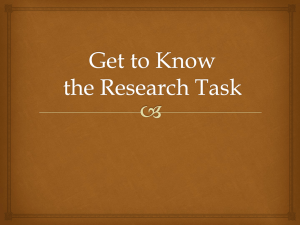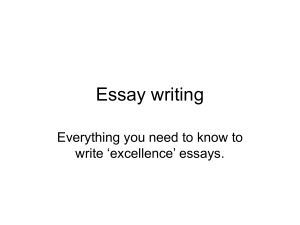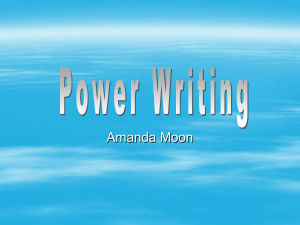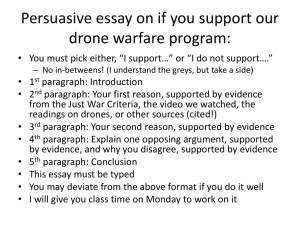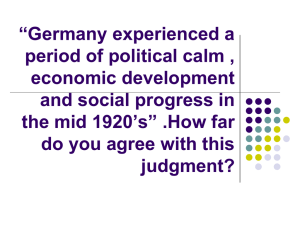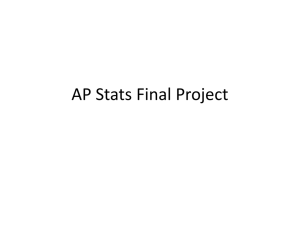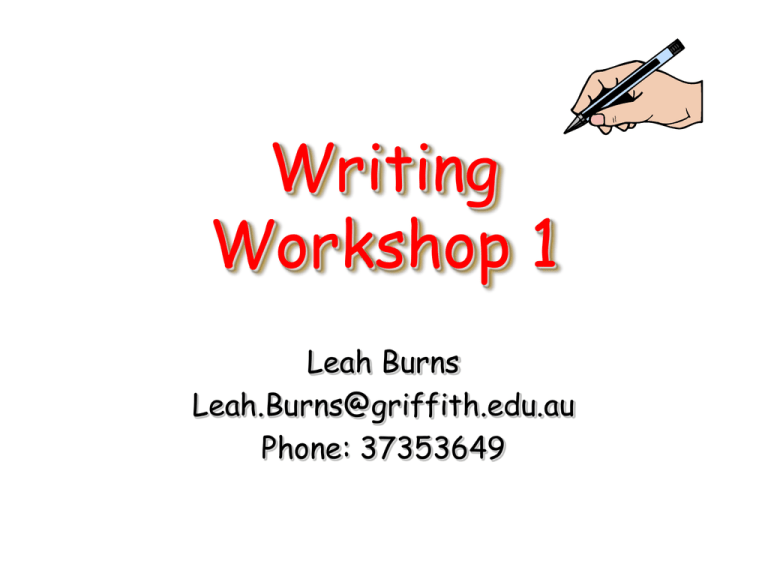
Writing
Workshop 1
Leah Burns
Leah.Burns@griffith.edu.au
Phone: 37353649
What we are going
to do today
•Discuss the minor and major assignments
•Develop strategies for researching and
writing the assignments
-Key words
-Types of questions
-Structure
-Referencing
The Major
Assignment
•Topic of your own choice relevant to course
•Worth 50% of total mark
•Due when you return to Volda
•Basis for oral exam
The Minor
Assignment
•5 questions - chose 1
•Worth 25% of overall mark
•2000 words
•Due in Brisbane – Friday 8 October
Writing
Assignments
Unpacking the
Assignment
Focus of the Assignment
• Why has this topic been set?
• What is this topic testing?
• What is the question asking me to do?
Key words help you decide
on the approach you take
• Topic words that highlight the major
concept
• Directive words that give direction on
approach you should take (e.g. examine,
analyse, compare)
• Limiting words that limit the scope of
the writing and research
EXAMPLE
‘What is multiculturalism, and is
there evidence that Australia is a
multicultural society?’
• Topic Words
– Multiculturalism, Society
• Directive Words
– What
• Limiting words
– Australia
Planning and
Structuring the
Assignment
Focus first on your
Overall Argument or Response
to the Assignment Topic
• Write a statement to clarify your
argument or position
– (If your assignment topic were a question,
what would your main answer be?)
• Be concise and clear. This argument is
central to how you structure the
assignment.
Minor Assignment Topics
1.
2.
3.
4.
5.
•
•
What is ‘multiculturalism’, and is there evidence that Australia is a multicultural society?
Use examples from your readings, as well as from your own experiences in Brisbane, to
support your answer.
The Saami in Norway and the Aborigines in Australia are both classified as ‘indigenous
people’. What similarities and differences, in terms of their relationships with the wider
national society, do these two groups of indigenous people share? In your answer make
reference to key historical events that have influenced the way in which both the Saami
and Aborigines currently live.
How are Aboriginal people represented in the Australian media? Over seven consecutive
days, compare stories from at least two different media sources (e.g., newspapers, radio
and television news broadcasts). In your answer, you should describe the main focus of
these stories and the attitudes they reflect.
Prior to visiting Australia you will have been exposed to different aspects of the
Australian identity. Now that you have spent time here, how have your perceptions of the
Australian identity changed? From your readings and your experiences, what features do
you think typify the Australian identity? In your answer, compare and contrast your prearrival notions of an Australian identity with your Brisbane and Bourke experiences.
Discuss 5 key environmental problems currently faced in Australia and 5 faced in Norway,
and address the following:
Are the main environmental issues faced by these two countries the same?
If not, why do they differ?
Your answer should refer to the history of engagement with environmental issues
in each country and speculate on their environmental futures.
Exercise - what to do
In groups based on each topic, discuss:
• The focus of the assignment
• The key words
• Overall response
• Ideas for how to start researching
the topic
Developing the Argument
• What are the main (key) points that will develop
your argument?
• In dot point form, jot down these main points
• Think about the best order for making these
points
• Check that each of these points is relevant to the
assignment topic and your overall response to the
topic
• Each one of these main points will become a topic
sentence in a paragraph
Number of words
• How long is a paragraph?
Paragraphs can range in word length, however:
– Plan for an average of about 100 words (6
sentences) per paragraph.
– A 2000 word essay will contain
approximately (and only approximately) 20
paragraphs
• If you have too many points for your
essay length, group related points
together to make one point.
Organise supporting detail
• Choose material that will provide
evidence to support or develop each of
the points you are making (Colour coding
information may help)
• Take note of the author and other
referencing details (year of text, page
number(s))
• Use this to expand your essay plan so
that you now have main points
and key details
Example
• 1st main point
– Evidence/support (author, referencing details)
– Evidence/support (author, referencing details)
• 2nd main point
– Evidence/support (author, referencing details)
– Evidence/support (author, referencing details)
Organise your references
• Create a list of all books, articles and
other resources you intend to
mention or cite within your essay.
– These will be needed for your
reference list
Reflect and Revise
• Allow time to revisit your plan so
that you can check that you are
making all the points necessary to
address the topic and to develop and
support your argument
• Try reading it aloud – you can often
hear if it is or is not flowing in a
logical way
You are now ready to
begin writing your
assignment …
Writing the Assignment
• Introduction
• Body (made up of paragraphs, may
also include maps or figures)
• Conclusion or summary
• A list of references
(bibliography)
• Appendix?
Introduction
• The introduction acts as a “roadmap” for
your readers
–
–
–
–
Introducing the topic or subject area
Stating the aim or purpose of the assignment
Showing the structure or overall plan
Indicating the limit or scope of the
assignment
– Stating the argument or thesis statement –
“This paper argues that …”
Body
• Paragraphs - each paragraph functions
like a ‘mini-essay’
• Topic sentence (usually the first sentence
of paragraph) states the key point of the
paragraph
• The body of the paragraph contains
explanations, evidence and examples
• Concluding sentence links the main idea
back to your argument, and the assignment
question
• Linking between paragraphs and sections logical flow
Conclusion or Summary
• This is a summary of your main points
• Importantly, your conclusion should:
– Contain no new ideas or information
– Summarise your key points briefly
– Relate key points directly back to the
question/ your argument
Reference List
• E.g.:
Cottrell, S. 2003 The study skills
handbook (2nd ed.). New York: Palgrave
• Check: Are the references in
alphabetical order?
• How many should you include?
The Major Assignment
• 8000 words
• Topic of your Own Choice
• Research Proposal due September 22
• Progress Report due October 20
• Draft due November 17
• Essay due December 10
Major Projects
Stine - pop groups in Brisbane: music
management
Ellie - sexism; women shaping Australia.
Inge - backpacking: economic
Sylvia - pub culture: pros and cons; addiction
Mona - immigration: Indian; aboriginal current policies
Maree - aboriginal art
- Heidelberg School
- History of Australian cinema
Josephine - changes in attitudes towards
aborigines
- Nick Cave
Jenny - sport & treatment of problem youth
Marianne -
Tanya - social work: sex trafficking; young people
& social change
Therese - Kathy Freeman; Palm Island
Camilla - aborigines; stolen children; barrier reef
Asa - irrigation in Murray darling basin
- Student art in Brisbane
Marit - writers
Sindre – rabbits
Aspin - sport & society
Stein - shark attacks: media angle
Andre: dangerous creatures
Martin: Midnight Oil
Multiple Choice Questions
1.
2.
3.
4.
5.
Direction words
a. highlight the major concept
b. give direction on the approach you should take
c. limit the scope of the research or writing
d. are the same as topic words
Which of the following is NOT the correct answer to the question: How long is a paragraph?
a. paragraphs vary in word length
b. most paragraphs are about 100 words long
c. most paragraphs are about 6 sentences long
d. a single sentence = a paragraph
Which of the following is NOT true about paragraphs?
a. the topic sentence is usually the first sentence in a paragraph
b. the topic sentence in a paragraph states the key point of the paragraph
c. a paragraph should contain no new ideas or information
d. each paragraph functions like a mini essay
The conclusion
a. can contain new ideas or information
b. is a summary of your main points
c. introduces the subject or topic area
d. provides necessary links between paragraphs and sections
Which of the following is TRUE about referencing?
a. it does not matter what style of referencing you choose as long as you are
consistent with it throughout the assignment
b. references should always be in chronological order
c. the reference list should appear at the start of the assignment
d. it is ok to include in your list of references any sources you found that are
relevant to the topic, regardless of whether they are cited in the paper
What we are going to do
in the next workshop
•Discuss a sample minor assignment
•Develop strategies for editing the
assignments
•Focus more on the major assignment
Before then …
You need to:
• Choose, research, and write first
draft of the minor assignment
• Have submitted research proposal
for major assignment (due 22/9) and
be very clear on the topic


